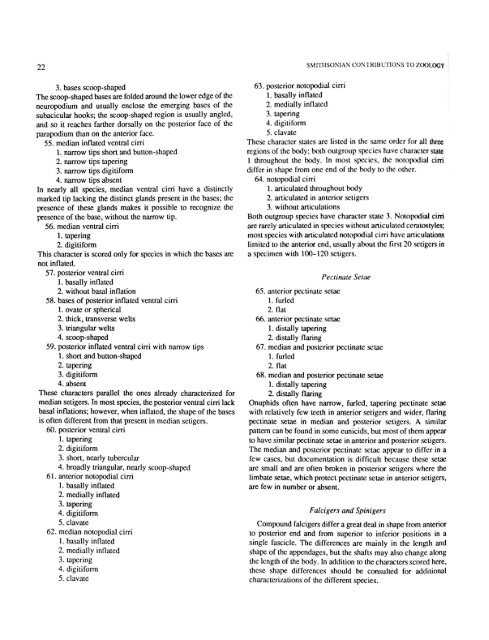A Review of the Genus Eunice - Smithsonian Institution Libraries
A Review of the Genus Eunice - Smithsonian Institution Libraries
A Review of the Genus Eunice - Smithsonian Institution Libraries
You also want an ePaper? Increase the reach of your titles
YUMPU automatically turns print PDFs into web optimized ePapers that Google loves.
22 SMITHSONIAN CONTRIBUTIONS TO ZOOLOGY<br />
3. bases scoop-shaped<br />
The scoop-shaped bases are folded around <strong>the</strong> lower edge <strong>of</strong> <strong>the</strong><br />
neuropodium and usually enclose <strong>the</strong> emerging bases <strong>of</strong> <strong>the</strong><br />
subacicular hooks; <strong>the</strong> scoop-shaped region is usually angled,<br />
and so it reaches far<strong>the</strong>r dorsally on <strong>the</strong> posterior face <strong>of</strong> <strong>the</strong><br />
parapodium than on <strong>the</strong> anterior face.<br />
55. median inflated ventral cirri<br />
1. narrow tips short and button-shaped<br />
2. narrow tips tapering<br />
3. narrow tips digitiform<br />
4. narrow tips absent<br />
In nearly all species, median ventral cirri have a distinctly<br />
marked tip lacking <strong>the</strong> distinct glands present in <strong>the</strong> bases; <strong>the</strong><br />
presence <strong>of</strong> <strong>the</strong>se glands makes it possible to recognize <strong>the</strong><br />
presence <strong>of</strong> <strong>the</strong> base, without <strong>the</strong> narrow tip.<br />
56. median ventral cirri<br />
1. tapering<br />
2. digitiform<br />
This character is scored only for species in which <strong>the</strong> bases are<br />
not inflated.<br />
57. posterior ventral cirri<br />
1. basally inflated<br />
2. without basal inflation<br />
58. bases <strong>of</strong> posterior inflated ventral cirri<br />
1. ovate or spherical<br />
2. thick, transverse welts<br />
3. triangular welts<br />
4. scoop-shaped<br />
59. posterior inflated ventral cirri with narrow tips<br />
1. short and button-shaped<br />
2. tapering<br />
3. digitiform<br />
4. absent<br />
These characters parallel <strong>the</strong> ones already characterized for<br />
median setigers. In most species, <strong>the</strong> posterior ventral cirri lack<br />
basal inflations; however, when inflated, <strong>the</strong> shape <strong>of</strong> <strong>the</strong> bases<br />
is <strong>of</strong>ten different from that present in median setigers.<br />
60. posterior ventral cirri<br />
1. tapering<br />
2. digitiform<br />
3. short, nearly tubercular<br />
4. broadly triangular, nearly scoop-shaped<br />
61. anterior notopodial cirri<br />
1. basally inflated<br />
2. medially inflated<br />
3. tapering<br />
4. digitiform<br />
5. clavate<br />
62. median notopodial cirri<br />
1. basally inflated<br />
2. medially inflated<br />
3. tapering<br />
4. digitiform<br />
5. clavate<br />
63. posterior notopodial cirri<br />
1. basally inflated<br />
2. medially inflated<br />
3. tapering<br />
4. digitiform<br />
5. clavate<br />
These character states are listed in <strong>the</strong> same order for all three<br />
regions <strong>of</strong> <strong>the</strong> body; both outgroup species have character state<br />
1 throughout <strong>the</strong> body. In most species, <strong>the</strong> notopodial cirri<br />
differ in shape from one end <strong>of</strong> <strong>the</strong> body to <strong>the</strong> o<strong>the</strong>r.<br />
64. notopodial cirri<br />
1. articulated throughout body<br />
2. articulated in anterior setigers<br />
3. without articulations<br />
Both outgroup species have character state 3. Notopodial cirri<br />
are rarely articulated in species without articulated ccratostylcs;<br />
most species with articulated notopodial cirri have articulations<br />
limited to <strong>the</strong> anterior end, usually about <strong>the</strong> first 20 setigers in<br />
a specimen with 100-120 setigers.<br />
Pectinate Setae<br />
65. anterior pectinate setae<br />
1. furled<br />
2. flat<br />
66. anterior pectinate setae<br />
1. distally tapering<br />
2. distally flaring<br />
67. median and posterior pectinate setae<br />
1. furled<br />
2. flat<br />
68. median and posterior pectinate setae<br />
1. distally tapering<br />
2. distally flaring<br />
Onuphids <strong>of</strong>ten have narrow, furled, tapering pectinate setae<br />
with relatively few teeth in anterior setigers and wider, flaring<br />
pectinate setae in median and posterior setigers. A similar<br />
pattern can be found in some eunicids, but most <strong>of</strong> <strong>the</strong>m appear<br />
to have similar pectinate setae in anterior and posterior setigers.<br />
The median and posterior pectinate setae appear to differ in a<br />
few cases, but documentation is difficult because <strong>the</strong>se setae<br />
are small and are <strong>of</strong>ten broken in posterior setigers where <strong>the</strong><br />
limbate setae, which protect pectinate setae in anterior setigers,<br />
are few in number or absent.<br />
Falcigers and Spinigers<br />
Compound falcigers differ a great deal in shape from anterior<br />
to posterior end and from superior to inferior positions in a<br />
single fascicle. The differences are mainly in <strong>the</strong> length and<br />
shape <strong>of</strong> <strong>the</strong> appendages, but <strong>the</strong> shafts may also change along<br />
<strong>the</strong> length <strong>of</strong> <strong>the</strong> body. In addition to <strong>the</strong> characters scored here,<br />
<strong>the</strong>se shape differences should be consulted for additional<br />
characterizations <strong>of</strong> <strong>the</strong> different species.
















